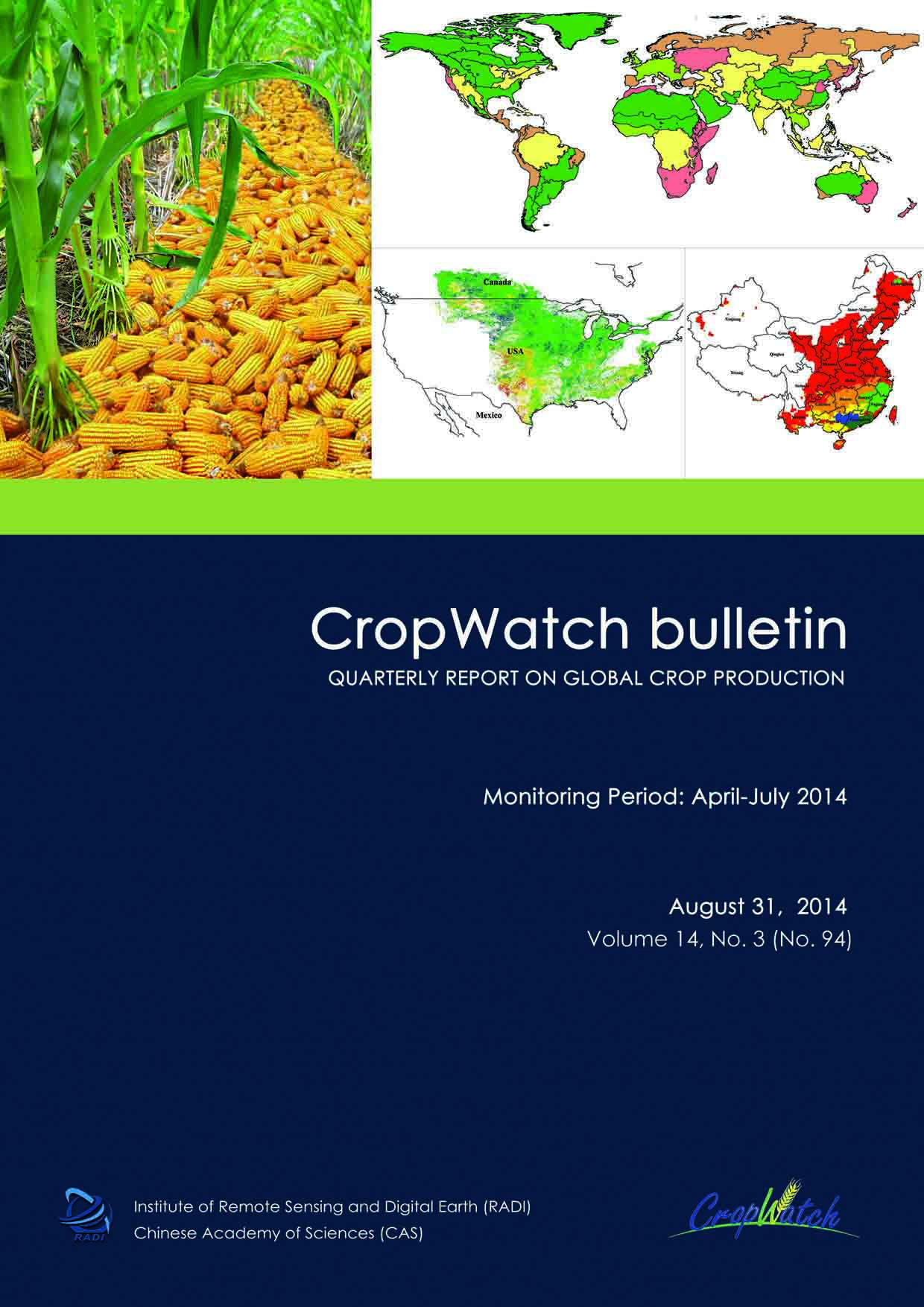
-
The CropWatch August bulletin assesses the agroclimatic and agronomic factors up to July 2014 that determine crop development. The analyses of environmental and satellite-based agronomic indicators focus on worldwide patterns and zoom into major production areas and countries. Over the reporting period, rainfall deficits and excess rainfall both markedly affect crop development. The bulletin reports on 2014 crop production estimates and also summarizes recent disasters and severe weather events that have impacted agriculture. The focus section further discusses El Niño perspectives and recent trends and an outlook for maize.
Key messages from the report:
- Droughts and excess rainfall, sometimes resulting in floods, have markedly influenced the development of crops in several large areas.
- East Asia is among the major rainfall deficit areas, with several regions in China severely affected. The drought was accompanied by moderate increases in temperature and radiation and the effect on crop production was severe.
- Temperature did not play a huge role over the reporting period and very limited areas experienced exceptional temperatures.
- Significant changes in cropped arable land occurred in Southern Australia, south and south-east Asia, and in the Gulf of Guinea countries.
- CropWatch projections for the global 2014 agricultural output include a poor performance of maize (-2.7%) compared with recent 2013 estimates and a near-stagnation of rice (+0.5%) and wheat (+0.3%) production. Soybean production is expected to increase (+4.4%).
- In China, wheat production is estimated to be slightly up (+0.5%) from last year’s, which puts the country’s total cereal production at 448million tons, virtually the same level as the 2013 output. Maize (191 million tons) is down 1.14% due to drought and rice stagnates at 201 million tons. Soybean continued the recent downward trend (-1.28%).
- An El Niño event in 2014 or in the spring of 2015 is still a possibility. CropWatch findings match the typical warm and dry events associated with an El Niño event.
Introduction
This CropWatch bulletin summarizes global crop condition developments and agroclimatic factors from April 1 to July 31 2014, focusing on key crop producing and exporting areas and China. The bulletin is prepared by the Institute of Remote Sensing and Digital Earth, Chinese Academy of Sciences in Beijing. The first part of the report includes the cover, table of contents, abbreviations, and a short overview of the bulletin sections.DownloadChapter 1. Global agroclimatic patterns
Chapter 1 describes the CropWatch agroclimatic indicators for rainfall (RAIN), temperature (TEMP), and radiation (RADPAR), along with the agronomic indicator for potential biomass (BIOMSS) for sixty-five global Mapping and Reporting Units (MRU).DownloadChapter 2. Crop and environmental conditions in major production zones
Chapter 2 presents the same indicators—RAIN, TEMP, RADPAR, and BIOMSS—used in Chapter 1, and combines them with the agronomic indicators—cropped arable land fraction (CALF), maximum vegetation condition index (VCIx), and minimum vegetation health index (VHIn)—to describe crop condition in seven Major Production Zones (MPZ) across all continents.DownloadChapter 3. Main producing and exporting countries
Building on the global patterns presented in previous chapters, this chapter assesses the situation of crops in 30 key countries that represent the global major producers and exporters or otherwise are of global or CropWatch relevance. For each country, maps present maximum VCI, spatial NDVI patterns, associated NDVI profiles, and an NDVI-based crop condition development graph.DownloadChapter 4. China
Chapter 4 presents a detailed CropWatch analysis for China, focusing on the seven most productive agro-ecological regions of the east and south: North-east China, Inner Mongolia, Huanghuaihai, Loess region, Lower Yangtze, Southwest China, and Southern China. After a brief overview including a production outlook for 2014, detailed analysis including maps and profiles for NDVI, VCIx, CALF, and BIOMSS are provided for the individual regions.DownloadChapter 5. Focus and perspectives
This focus section complements CropWatch analyses presented in chapters 1 through 4 by presenting a global outlook for 2014 production, as well as other topics of relevance to global agriculture. The section includes a summary of the provisional CropWatch estimates for 2014 production, followed by an overview of extreme atmospheric factors—disaster events—that have interfered with crop production over the monitoring period. The two remaining sections focus on El Niño and maize, respectively.DownloadAnnex A. Agroclimatic indicators
Tables in this Annex provide additional information about the agroclimatic indicators—RAIN, TEMP, and RADPAR—as well as BIOMSS for the various CropWatch spatial units for this reporting unit. Those units include the Measuring and Reporting Units; the thirty-one main producing and exporting countries; regions or provinces within large countries—Argentina, Australia, Brazil, Canada, India, Kazakhstan, Russia, and the United States; and China.DownloadAnnex B. 2014 Production estimates
Annex B includes tables with the 2014 production estimates for Argentina, Australia, Brazil, Canada, and the United States.DownloadAnnex C. Quick reference guide to CropWatch indicators, spatial units, and production estimation methodology
Annex C includes a brief overview of the CropWatch indicators and spatial units (including the MRUs, MPZs, and countries), along with a description of the production estimation methodology.Download

